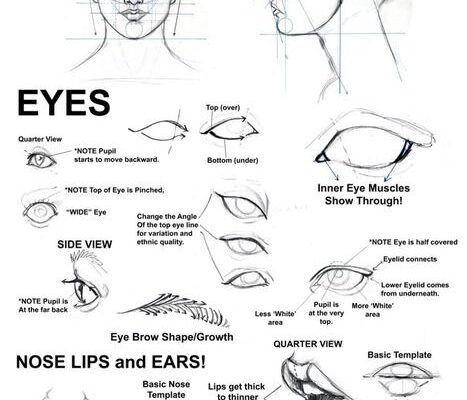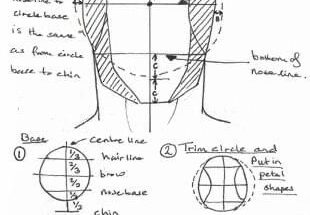Face Patterns Unveiled: A Detailed Tutorial on Drawing Eyes, Nose, Lips, and Ears by Brandon McKinney

Elevate your portrait drawing skills with this comprehensive Face Patterns tutorial by renowned artist Brandon McKinney. Designed for artists seeking to master the anatomical intricacies of the human face, this guide provides a step-by-step breakdown of drawing eyes, nose, lips, and ears with precision and style. Featuring detailed sketches and annotations, it’s perfect for beginners and intermediate artists aiming to create realistic or stylized portraits with confidence.
Explore the annotated illustrations above to learn how to construct facial features using templates, understand muscle growth, and apply consistent angles across different views. Whether you’re working on a front-facing portrait or a dynamic quarter view, this tutorial equips you with the tools to capture the essence of every facial element.
Core Principles of Face Drawing
- Proportional Consistency: Use guidelines to align features with the head’s structure.
- Anatomical Awareness: Understand muscle placement and growth patterns for realism.
- Angle Replication: Maintain the same angles (e.g., “M” shape) across features for harmony.
- Template Utilization: Start with basic shapes to build complex forms.
Step-by-Step Breakdown of Facial Features
1. Eyes: The Windows to Expression
- Quarter View:
- Top (Over) & Bottom (Under): Sketch the eyelid curve, noting the pupil’s movement.
- Note: Pupil starts to move backward, changing the angle for ethnic variation.
- Wide View:
- Focus on the eyebrow’s outer edge and pupil placement for depth.
- Side View:
- Note: Pupil is at the far back; adjust the angle to reflect the profile.
- Eye Brow Shape/Growth:
- Map muscle growth with curved lines, starting thin and thickening toward the center.
- Inner Eye Muscles:
- Show Through: Draw eyelid contours, with the lower eyelid half-covered by the upper.
- Details: Less white pupil area at the top, more white at the bottom for realism.
- Basic Template:
- Use a simple oval to establish the eye shape, refining with inner details.
2. Nose, Lips, and Ears: Structural Harmony
- Nose:
- Nose Shape Underneath: Draw an “M” shape beneath, mirroring the top lip’s form.
- Basic Template: Start with a triangular base, adjusting for thickness.
- Lips:
- Lips Get Thicker to Thinner: Sketch from a full template, tapering at the angle.
- Same Angles!!: Align lip curves with the nose’s “M” shape for consistency.
- Ears:
- Ear Has a “?” Shape: Begin with a question mark curve, adding inner folds.
- Basic Template: Use a curved line to establish the ear’s outer edge.
Practical Workflow
- Sketch the Head Framework:
- Draw a circle for the cranium, adding guidelines for eye level, nose base, and chin.
- Place Features:
- Eyes: Midway down the head.
- Nose: Between eyes and chin (about ⅓ down).
- Lips: ⅓ below the nose.
- Ears: From eye level to nose base.
- Apply Templates:
- Use basic shapes (ovals for eyes, triangles for nose) as starting points.
- Refine with Growth Patterns:
- Add muscle contours and adjust for view (front, side, quarter).
- Maintain Angles:
- Ensure consistent “M” shapes and curves across features.
Time Estimate: 10–20 minutes per feature with practice.
Pro Tips for Realism
- Eye Variation: Adjust pupil placement and eyelid angle for ethnic or stylistic differences.
- Lip Thickness: Thicken the center, thinning toward the edges for natural flow.
- Ear Placement: Align the “?” shape with the head’s side plane, varying size slightly.
- Quarter View: Exaggerate depth by shifting the pupil and nose profile.
- Shading: Add light shadows under eyelids and lips to enhance 3D effect.
Common Mistakes & Fixes
| Mistake | Cause | Fix |
|---|---|---|
| Uneven eyes | Misaligned guidelines | Recheck eye level |
| Flat nose | No “M” shape | Add underneath contour |
| Thin lips | Over-tapered edges | Thicken center more |
| Off-angle ears | Incorrect placement | Align with eye-nose span |
Tools & Materials
- Pencils: HB (guidelines), 2B (outlines), 4B (shading)
- Paper: Smooth sketchbook or Bristol board
- Eraser: Kneaded for clean adjustments
- Optional: Red pencil for initial guidelines
Downloadable Resources
- PDF Guide: Printable face pattern templates (eyes, nose, lips, ears)
- PSD File: Layered sketches for digital practice
- Video Tutorial: 15-minute walkthrough by Brandon McKinney (coming soon)
- Reference Pack: 10 annotated portraits with feature breakdowns
Ideal For:
- Portrait artists and illustrators
- Anime/manga creators
- Beginner to intermediate drawers
- Art students studying anatomy
- Self-taught artists refining skills
Draw Faces with Precision and Personality. With Brandon McKinney’s Face Patterns system, you’ll master the art of drawing expressive eyes, defined noses, lush lips, and perfectly placed ears. Build a solid foundation and bring your portraits to life with anatomical accuracy.
Follow the detailed illustrations above and start perfecting your face drawings today.



